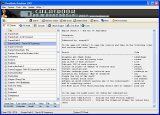Quest Master
Cheat Codes:
------------
Submitted by: David K.
How to Make Best Dungeon:
-------------------------
Writen by SirAston
While they certainly are different beasts, any aspiring dungeon dungeon
for Quest Master would do well to keep core lessons from other media
about dungeon design in mind, finding what is applicable, what is not,
and what works surprisingly well with some adjustment. Considering the
game will allow for couch co-op, guides for tabletop games may offer more
insight than one might think.
-=The Three M's=-
* Motive: Now this one can be safely skipped for now, at least until we
know that the devs are cooking for the Overworld system. But this can be
replaced with its cousin, theming. Having a strong theme goes beyond
picking a neat tileset, it also involves deciding on a core element or
gimmick for the dungeon and making it the centerpiece of dungeon design.
The games that inspired Quest Master don't do it much differently after
all, why reinvent the wheel?
* Monsters: This is pretty straightforward at first glance, but the purpose
of monsters in a dungeon is also to reflect upon the motive, or theming,
of the dungeon. It's best to limit yourself to a small core pool of monsters
to give the dungeon an identity instead of plunging all avaible enemy types
into the rooms. Note that I've said "core pool", nothing stops you from
having the occasional surprise monster as long as they are introduced or
telegraphed properly. An example would be using teleporters to create a
"two worlds"-style of dungeon where the "other world" features a different
core pool of monsters. A good twist and a strong theme remains.
* Map: Now that's what we're primarily here for. But even here, the layout
of the rooms and how they flow into each other, including decorations,
should reflect the motive and theming of your dungeon. The most major tip
I can give here is: Never make filler rooms. Give each room a purpose in
some way. A combat challenge. A puzzle room. A dedicated treasure room. A
central hub. A corridor visibly separated from a major point like a
treasure chest to raise anticipation. Even a short decorative corridor
with no enemies, puzzles or traps can be given purpose as a "breather"
room when there has been a series of exhausting rooms.
-=Miller's Law=-
Named after George Armitage Miller, Miller's Law is stating the average
limit of the human short-term capacity. Basically, the average human is
capable of keeping seven different types of information in the short-term
memory.
With that knowledge, the perfect number of core entities, elements
repeatedly present throughout the entire dungeon, is, you guessed it,
seven. Entities meaning enemies, items and common obstacles. Wanna utilize
moving floors in several rooms? That's a core entity. Is your dungeon
Cobra City? That's another core entity. Do you love your fire bars? You
guessed it, core entity. Bombs? All player items can be considered core
entities. While levers and switches usually don't count since they're
normally single-room entities, if you wanna utilize color switches or
multiple switches/levers affecting different rooms, those will definitely
occupy the short-term memory.
Note that there are two exceptions from the rule of seven. The first is
the sword, which is an omnipresent tool in most dungeons and relegated to
muscle memory. Another exception is the final boss and potentially the
mid-boss, since the final boss is at the end of the dungeon, thus it can
safely override the memories of core entities.
-=The F.A.T.E. Principle=-
Map design features many theories, and for aspiring catacomb constructors,
I recommend doing F.A.T.E., which stands for First Impression, Addition,
Twist, and End.
* First Impression: This is the first room or first rooms of the dungeon,
which should serve the primary purpose of introducing to the gimmick and
theming of the dungeon. Start with a simple puzzle to introduce the core
gimmick, start with the easy enemy types within your core pool. This could
be the very first dungeon a future Quest Master player might play, so don't
skimp on the First Impression. Even veteran players can utilize these
starting rooms well to get a feel for how the rest of the dungeon might
play out. Example switch puzzle: A single lever that, when flipped, lowers
a raised pillar, opening the path forward.
* Addition: Called such because it expands upon the established gimmicks.
It's where you're showing that your dungeon has some teeth, and also a
great place to really delve into the motive and theming of the dungeon.
It's also likely the best spot to introduce a hub room if your dungeon
features one. Example switch puzzle: The path is obstructed by a number
of raising pillars, and only the right combination of activated levers
makes all the pillars sink into the floor.
* Twist: This is where the fun starts. Iterate on established gimmicks
and remix them to challenge and surprise the players. Have them think
outside the box for puzzles, and use unusual room designs and enemy
combinations to spice up combat challenges. Example switch puzzle: The
levers will lower certain pillars while raising others, so players will
have to ponder about the sequence of action to utilize if they wish to
advance.
* End: Guess when you will incorporate these kind of rooms. This is the
place where you will throw in your most complex puzzle and your most devious
enemy setup, which includes the dungeon boss. Think of this as the "final
exam" your dungeon offers to the player. Example switch puzzle: Even this
guide will challenge you at the End by encouraging you to think about how
to combine levers and raising pillars into a mini maze…
-=Designing with F.A.T.E.=-
For this principle, it's best as a labyrinth laborer to start simple and
straightforward. Build four rooms, your F, your A, your T, and your E, in
sequence. That way, you already have an idea that the core route is
possible. From there, create more rooms that branch off from these core
linear rooms and include progress blockers (like key doors) between said
core rooms and progress enablers (like keys) at the end of your branching
paths.
Due to the nature of branching paths off the core rooms, you ensure that
players will face your core rooms first and in sequence, basically making
them good signals that the dungeon will shift gear at that point. It also
introduces a certain flow to the dungeon as the players will inevitably
return to a core room to go to the next core room once they got a key,
making those four core rooms kinda act like invisible hubs.
-=Graduating from F.A.T.E.=-
The F.A.T.E. principle is always useful, but as your expertise as a maze
manufacturer expands and grows, so will your toolbelt and theoretical
understanding of game design. While the idea behind F.A.T.E. should never
be ditched, changing up the layout so a core room flows into an "interim"
room before entering the next core room can be effective as long as the
interim room has a clear purpose and doesn't confuse the player's sense of
map layout. Once you've learned the rules, break them with care to offer
more varied and variable dungeons.
But always show your players the motive and theming of your dungeon. It's
the glue that keeps players and your dungeons together and you don't want
to get stingy on that.
 |
|
|
CheatBook DataBase 2025 is a freeware cheat code tracker that makes hints, tips, tricks
and cheats (for PC Cheats, Walkthroughs, PSP, Sega, iPhone, Wii U, Playstation, Playstation
2, XBox, Playstation 3, Nintendo 64, DVD, Gameboy Advance, Gameboy Color,
N-Gage, Nintendo DS, gamecube, XBox 360, Dreamcast, Super Nintendo) easily
accessible from one central location. (Release date January 11, 2025)
- All Cheats and Codes inside from the first CHEATBOOK January 1998 until today.
More Infos |
| | |
|

